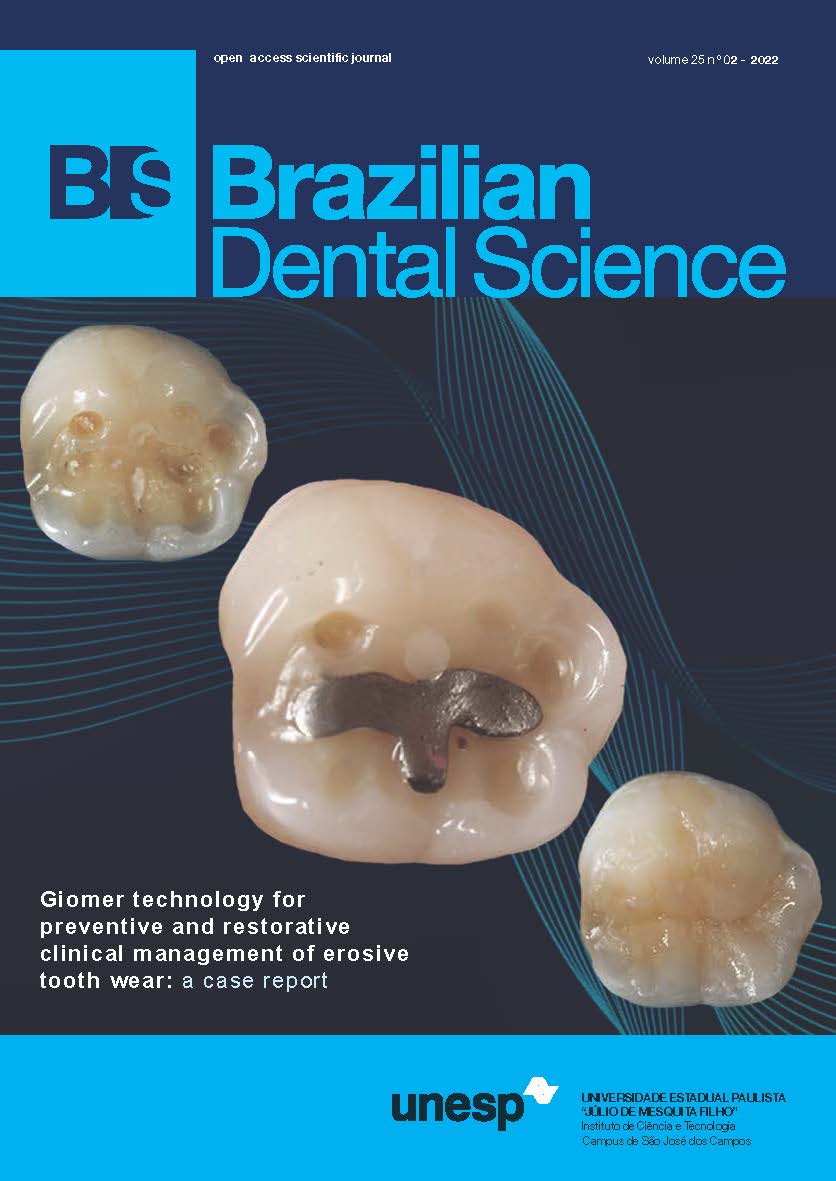Sodium trimetaphosphate combined to calcium as a strategy to improve dentin-bonding interface
DOI:
https://doi.org/10.4322/bds.2022.e3053Resumo
Objective: The aim of this study was to evaluate the effect of STMP as biomimetic analog of dentin matrix on
the dentin bond strength submitted to artificial cariogenic challenge over time. Material and Methods: The total
number of teeth used in the experiment was 60 teeth, which were divided into 6 groups (n = 10). Of these total
amount, 10 teeth were not submitted to the artificial cariogenic challenge (ACC), serving as control group (Sound
Dentin - SD) while the other 50 were submitted to an ACC (7d/37ºC), being treated with treatment solutions
according to each group: SD- deionized water/sound dentin, CD- deionized water/ artificial caries dentin, GIIISTMP,
GIV- STMP + Ca(OH)2, GV- STMP + NaF, and GVI- NaF. After treatments (24h), the specimens were
restored (Adper Single Bond Universal + Filtek Z250), to obtain resin–dentin sticks with a cross sectional area of
0.8mm2, approximately. Two-third of these sticks were stored in artificial saliva (37°C) for analyzes after 6 and
12 months. The 1/3 remains were subjected to mTBS test (baseline). Data were analyzed by two-way ANOVA
and Tukey tests (p<0.05). Results: In general, the highest mTBS values were obtained in sound condition
(SD), while the artificial caries condition (CD) determined minimum values. Groups treated with NaF (with or
without STMP- GV and GVI) were not able to improve adhesion over time. Only the use of STMP + Ca(OH)2
(GIV) improved the mTBS compared to the others caries-challenged dentin after 1 year. The adhesive failure
pattern was predominant in all time. Conclusion: The use of the STMP associated with Ca(OH)2 seems to be a
viable therapeutic strategy conciliating the biomimetizing capacity to the adhesive process satisfactorily even its
performance is not superior to initial condition.
KEYWORDS
Dentin; Dental adhesive; Protease inhibitors.
Downloads
Downloads
Publicado
Como Citar
Edição
Seção
Licença
TRANSFERÊNCIA DE DIREITOS AUTORAIS E DECLARAÇÃO DE RESPONSABILIDADE
Toda a propriedade de direitos autorais do artigo "____________________________________________________________________" é transferido do autor(es) para a CIÊNCIA ODONTOLÓGICA BRASILEIRA, no caso do trabalho ser publicado. O artigo não foi publicado em outro lugar e não foi submetido simultaneamente para publicação em outra revista.
Vimos por meio deste, atestar que trabalho é original e não apresenta dados manipulados, fraude ou plágio. Fizemos contribuição científica significativa para o estudo e estamos cientes dos dados apresentados e de acordo com a versão final do artigo. Assumimos total responsabilidade pelos aspectos éticos do estudo.
Este texto deve ser impresso e assinado por todos os autores. A versão digitalizada deverá ser apresentada como arquivo suplementar durante o processo de submissão.




























